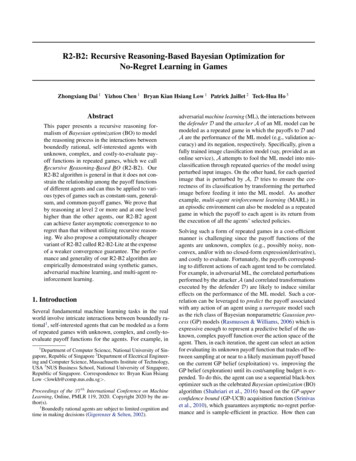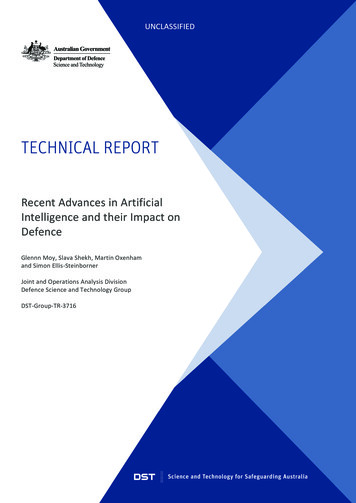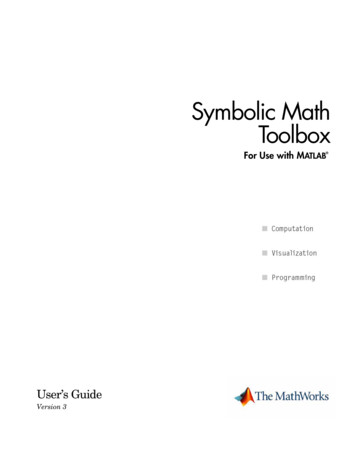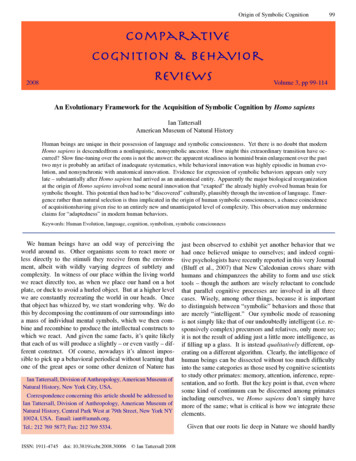
Transcription
Approved for public release; distributionis unlimitedSymbolic Reasoning in the Cyber Security DomainJune 2007Michael Kandefer, Stuart C. Shapiro, Adam Stotz, and Moises Sudit{mwk3,shapiro}@buffalo.edu, stotz@cubrc.org, and sudit@eng.buffalo.eduDepartment of Computer Science and Engineering, Center for Cognitive Science, andThe National Center for Multisource Information Fusion.University at Buffalo, Buffalo, NY, 14260-2000.ABSTRACTCyber Security can benefit greatly from the association and combination of data andinformation from multiple sources. A data repository of system vulnerabilities, a networkscanning tool, and the advice of a systems analyst trained in cyber security can all aid inidentifying and preventing intruders. Previous attempts at information fusion in cybersecurity have largely concerned themselves with the "tangible" information sources, butthis ignores an important resource in solving problems in this particular domain --- thecyber security expert's reasoning process. The National Center for Information Fusion(NCMIF) has begun implementing a solution that partially automates the cyber securityexpert in the intrusion detection process through a combination of information fusiontechniques and symbolic reasoning, using the SNePS knowledge representation,reasoning, and acting system.Our methodology approaches cyber security problems by fusing information fromexternal information repositories into a SNePS-based agent‟s knowledge base. We haveidentified five information sources that are useful: the background knowledge of a cybersecurity subject matter expert (SME); Nessus security scan reports; the CommonVulnerabilities and Exposures (CVE) database; and INFERD template graphs. TheSNePS system makes use of higher-order logic to represent information about theexternal world. Facts are represented as proposition-valued terms, and the SME‟sreasoning procedures are represented as logical rules.We have also developed a Graphical User Interface to SNePS that facilitates thedevelopment and maintenance of the knowledge base. Dissemination of knowledge baseswill be accomplished via files using OWL and the RDF markup language.
1.0IntroductionThe National Center for Multi-source Information Fusion (NCMIF) [1] has endeavoredto combine the techniques of information fusion and knowledge representation andreasoning to provide a solution to problems in the cyber security domain. We presenthere a subtask in this goal. This task is responsible for providing a cyber securityknowledge base that can test INFERD [7] template graphs in order to gain a betterunderstanding of a hacker attack. For our purposes we have selected the SNePSKnowledge Representation and Reasoning System [6] to accomplish this task, which canbe further subdivided as follows:Represent the selected information in SNePS.Use the SNePS reasoning engine to aid information fusion and cyber security.Provide a method of interfacing with the SNePS system.Improve the system, as needed, to accomplish the previous.Fusing the information sources into a common, logical representation language allowsour reasoning engine to treat disparate sources as if they were one, and reason about thecontents of these sources. In addition, we have developed two methods of interfacingwith the system, a Java-to-SNePS API and a SNePS GUI. The former allows for Javaprograms to assert information in the SNePS system and construct logic-based queries tothe system. The SNePS GUI provides users various alternative methods of insertinginformation into SNePS using visualized SNePS networks and hierarchies. This paperdiscusses the information sources we are using, the representation of those sources, andthe developed and forthcoming interface features.2.0 Symbolic Reasoning in SNePS and Information FusionRepresenting information in symbolic logic not only allows for the contents of theseinformation sources to be fused into a common representation language, but also allowsvarious reasoning tasks to be performed on the logical representation. Logical rules canbe applied to deduce new information from existing information. For example, givenrules about the structure of a class membership hierarchy, a traditional logic-basedsystem can determine class membership. SNePS is one such system, but also provides anumber of other useful representational and functional facilities that can aid informationfusion and reasoning in the cyber domain. These include the capabilities to:represent and distinguish co-referential terms;represent meta-knowledge;detect contradictions.The SNePS system was designed to handle co-referential terms in a way that provideseach term its own unique intentional denotation, but allows for these terms to co-referusing equivalence relationships. Such a representation technique can provide a sense foran entity that is unique to each information source. SNePS can also represent knowledgeabout knowledge. Such a feature is capable of representing what SNePS knows about theknowledge contents of the external information sources.Apart from representational features, one functional feature of the SNePS system is its2
capability for belief revision. The system can automatically detect contradictoryinformation and present it to the user of the system. After the user selects the informationto reject, an automatic repair propagation procedure is invoked. Such a feature is desiredin information fusion as different external sources may contain contradictoryinformation.3.0 Representing the Information sourcesWe have identified five information sources that will aid in reaching our goals: thebackground knowledge of a cyber security subject matter expert (SME); Nessus securityscan reports; Common Vulnerabilities and Exposures (CVE) database; SNORT Sensorrules; INFERD template graphs. A description of these and how they are representedfollows:3.1 SME Background knowledgeOf the five information sources the SME's background knowledge is the most difficult toelicit. In order to accomplish this we're taking our task one step at a time, analyzing thequestions we want answered at the current step, and then asking the SME how they'd goabout it. Through this process we have identified a number of external information toolsto aid us, as well as constructed reasoning axioms that can answer the current questionsunder consideration. Presently, the process under consideration is determining if anINFERD attack track for a particular host is a false positive, or true-positive. We havedetermined with the help of the SME this can be done by examining the vulnerabilities ofthe system using the Nessus security scanning tool (Section 2.2) and comparing theirCVE identifiers (Section 2.3) against the Signature identifiers (SID) provided in theattack track. In order to do this two translations are accomplished; one from SID to BID(Bugtraq ID), and one from BID to CVE identifier. This extra complexity step waschosen as the CVE repository has more entries with BIDs, than SIDs.Simply put, if the CVE identifier provided by Nessus for a particular host does not matchthe SID identifier provided by INFERD for that host, the track can be regarded as a falsepositive, otherwise it's a true-positive or that a vulnerability exists on the system but wasnot found by Nessus (a possibility we‟re discounting provisionally). This procedure waschosen since it is possible for INFERD to generate attack tracks for vulnerabilities thehost in question doesn‟t possess, and as such, they should be rejected. Therepresentation of this reasoning process uses proposition-valued terms with the followingsemantics:PropertyValue(x,y,z) - Entity x has a property y with value zCVE BID Equiv(c,b) - CVE identifier c refers to the same vulnerability that BIDb refers to.SID BID Equiv(s,b) - SID s refers to the same vulnerability that BID b refers to.TruePositive(x,c,s) - Entity x has a true-positive when it is known to have avulnerability referred to by a CVE identifier c and SID s.3
This reasoning rule is expressed in SNePSLOG1 as:all(cid,bid,sid)(SID BID Equiv(sid,bid) (CVE BID Equiv(cid,bid) all(x)({PropertyValue(x,CVE,cid), PropertyValue(x, BID, bid),PropertyValue(x, SID, sid)}& e(x,CVE,cid) all(bid)(CVE BID Equiv(cid,bid) PropertyValue(x,BID,bid))).The above rules represent the following propositions: If a particular host x is known tohave a particular SID sid , BID bid, and CVE identifier cid; and that sid, bid, and cidrefer to the same vulnerability, then INFERD generated an attack track that is a truepositive. It is assumed by the INFERD interface to SNePS that after providinginformation about a particular attack track that if the system doesn‟t reason to a truepositive that the track is a false-positive.Apart from the above reasoning rules, some general rules are provided to the system forthe task at hand as well as in anticipation for future reasoning tasks. Among these aregeneral “part of” and “class membership” rules. The two “part of” rules are as follows:1) all(x,y,z)({PartOf(x,y),PartOf(y,z)} & {PartOf(x,z)}).2) all(p,v,x,y)({SubsumedProperty(p), PropertyValue(x,p,v), PartOf(x,y)}& {PropertyValue(y,p,v)}).The first rule provides the system with the capability to reason that the “part of”(expressed as PartOf in our logic) relationship is transitive. For example, if host h1 ispart of network n1, and port p1 is part of h1, it can be concluded p1 is part of thenetwork n1. The second rule is specifically tailored for properties the system believes aresubsumed by parent parts (expressed as SumbsumedProperty). This rule was selected asNessus reports only that ports have a specific vulnerability on them, but our desired goalis to know if certain hosts have vulnerability. By asserting that CVE, BID, and SIDvulnerability identifiers are a subsumed property the system can know which hosts havea vulnerability, if it knows one of its ports has that same vulnerability.The class membership rules are as follows:1SNePSLOG is a logical language resembling higher-order logic that can be used as an interfaceto SNePS4
1) all(x,y,z)({Isa(x,y),Ako(y,z)} & {Isa(x,z)}).2) all(x,y,z)({Ako(x,y),Ako(y,z)} & {Ako(x,z)}).Though the above rules aren‟t used by the current task, they are helpful in establishing ahierarchy of class member information, and will aid in future reasoning goals. The firstrule asserts that if some entity is a member of some class (represented by the Isapredicate), and that class is a subclass, or a kind of, another class (represented by the Akopredicate), then that entity is a member of the superclass as well. The second ruleprovides a the transitivity rule to the Ako relationship.3.2 NessusNessus [4] is a system security tool that analyzes a specified set of hosts on a network forsecurity vulnerabilities. Reports on these vulnerabilities are generated as an XML file,which details ports on the scanned hosts and CVE identifiers for vulnerabilities detectedon those ports. Additional information can include the operating systems running on thehosts, network trace routes, host aliases, and severity of the vulnerability. An example ofthe Nessus output is presented in Fig. 1. host hostname "192.168.1.10" [.] port portname "netbios-ns (137/tcp)" alert hostname 192.168.1.10 /hostname portname netbios-ns (137/tcp) /portname id 10150 /id level NOTE /level desc [.]CVE : CVE-2000-1194 /desc /alert /port /host Figure 1: Sample Nessus output from our test network.After generating a report we utilize a PERL program to parse the needed informationfrom the file and represent it in the SNePSLOG syntax. These become facts in ourknowledge base. The following proposition-valued terms are required to represent the5
Nessus report:PropertyValue(x,y,z) - Entity x has a property y with value zIsa(x,y) - Entity x is a member of the category of yPartOf(x,y) - Object x is a part of object yAbout(x,y) - x contains information about yAs are the following terms:Network - the category of networksHost - the category of hosts.Alert - the category of alerts.Active Port - the category of active ports.CVE-xxxx-xxxx - a specific CVE identifier where each x can be a distinct digit.x.x.x.x - a specific IP address where each x can be a number between 0 and 255.low - the low severity level, or what Nessus denotes with “NOTE”tcp - the tcp/ip protocolPlugin Id - an identifier that uniquely identifies the structure of the informationcontained in an alertSeverity – property that represents the severity level of an attackIP Address - the IP address propertyNumber - the port number propertyProtocol - the protocol propertyThe PERL script traverses the file looking for specific tags, and contents to generateSNePSLOG expressions. As it encounters tags we have determined to refer to certainentities (e.g. host, port, and alert) the PERL program creates a unique identifier for theentity. This identifier is merely the first letter of the entity in question followed by anumber (e.g p12' would refer to the twelfth port encountered. An example of theSNePSLOG expressions resulting from a parse of the Nessus data in Fig. 1 is pictured inFig. 2. Note that Nessus doesn't explicitly have tags referencing the network, but thehosts in a Nessus file are a part of a network, so an identifier needs to be provided inorder to form propositions about the scanned network. This identifier is n1'.6
Isa(n1, Network).PartOf(h2, n1).Isa(h2, Host).PropertyValue(h2, IP Address, 192.168.1.10).Isa(p45, Active Port).PropertyValue(p45, Number, 137).PropertyValue(p45, Protocol, tcp).About(a96, p45).Isa(a96, Alert).PropertyValue(a96, Plugin Id, 10150).PropertyValue(a96, Severity, low).PropertyValue(a96, CVE, CVE-2000-1194).Figure 2: Sample SNePSLOG output from the Nessus parser3.3 CVE RepositoryCVE [2] is a database of common system vulnerabilities. It is available as an XMLdownload, and is required for our purposes because it not only documents vulnerabilitiesacross multiple operating systems, but also serves as a cross-reference for vulnerabilityreferents. For example, the INFERD tracks use SIDs, which are translated to BIDs(Section 2.4), when identifying particular vulnerabilities, while Nessus uses CVEidentifiers. Using this capability to cross reference CVE identifiers with BIDs, anINFERD track is determined to be a false-positive if the track‟s SID references avulnerability whose CVE identifier doesn‟t reference that same vulnerability. This is aresult of INFERD generating an attack track for a vulnerability the host doesn‟t possess,and thus, the track can be discarded.This cross-referencing task is performed by the SNePS attached procedures facility. Thesize of the CVE repository prevents us from loading in all its information into a SNePSknowledge base without hindering the reasoning processes. Additionally, constantlyconsulting the web-site or XML file for entries would be computationally expensive.Thus, we use a PERL script to create a Lisp hash-table indexed on CVE identifiers, withvalues of BIDs and the ability of the attached procedures facility to integrate Lispstructures with the symbolic reasoning of SNePS.Below is a sample of a few entries in the CVE database after being translated into Lisphash-table code, which adds entries for every CVE-BID pair contained in the repository:7
(setf (gethash 'CVE-1999-0002 *cve-table*) '(121 ))(setf (gethash 'CVE-1999-0003 *cve-table*) '(122 )) (setf (gethash 'CVE-1999-0842 *cve-table*) '(827 ))(setf (gethash 'CVE-1999-0844 *cve-table*) '(823 820)) (setf (gethash 'CVE-2000-1194 *cve-table*) '(1227 ))These entries are connected to SNePS through the proposition-valued termCVE BID Equiv(cve,bid), which is ultimately attached to the Lisp function specified inFig. 3. For our purposes, we mostly rely on this function to determine if a CVE identifierrefers to the same vulnerability as a given BID. Thus, CVE BID Equiv(CVE-1999-0844,820) would return as known to the knowledge base, while CVE BID Equiv(CVE-19990002, 1811) would be unknown. This process allows our logical formalism to connect itssymbolic representation with efficient Lisp functions in a similar manner to Prolog‟sarithmetic facilities. After the Lisp function terminates, the information is cached in theSNePS knowledge-base.(define-attachedfunction cve-bid-equiv ((cve) (bid)) If given two symbols, returns true'' if an entry exists in the hash-tablewith a key of cve, and the list of corresponding bids contains bid. If given asymbol for cve and variable for bid this will bind to the variable all the bidscorresponding to the cve”(cond((and (symbolp cve) (integerp bid))(if (member bid (gethash (intern cve :snepslog) *cve-table*)) ((snip:pos nil)) ((snip:neg nil))))((and (symbolp cve) (sneps:isvar.n bid))(if (first (gethash (intern cve :snepslog) *cve-table*))(loop for elm in (gethash (intern cve :snepslog) *cve-table*))collect (cons 'snip:pos (((,bid . ,elm)))))nil))(t nil)))Figure 3: Attached function definition for cve-bid-equiv3.3 SNORTSensorRulesSNORT Sensor rules [5] are used in a similar manner to the CVE repository. They are8
structured text files that contain information that defines (possibly) malicious networkpackets or sequences of network packets. Without these rules, the Snort sensor wouldproduce no alerts. When the rule is triggered by sensed network activity, the signature andunique SID associated with the rule is generated as information within the alert. We utilizethese rules to establish a correlation between SIDs and BIDs, and ultimately SIDs and CVEsthrough the use of the CVE Repository (Section 2.3). Like the CVE parsing describedpreviously, these files are parsed and used to create a Lisp hash-table keyed on SIDs withlists of corresponding BIDs as the value. An example of the results are as follows(setf (gethash 494 *sid-bid-table*) '(1806 ))(setf (gethash 497 *sid-bid-table*) '(1806 )) (setf (gethash 1888 *sid-bugtraq-table*) '(5427 ))(setf (gethash 1734 *sid-bugtraq-table*) '(10078 1227 1504 1690 4638 7307 8376 ))These entries are connected to SNePS through the proposition-valued termSID BID Equiv(cve,bid), which shares a similar implementation to the attachedprocedure CVE BID Equiv, but on the *sid-bid-table*.3.4 INFERD Attack TracksFigure 3 - INFERD Holistic ArchitectureINFERD (Information Fusion Engine for Real-time Decision Making) is a perceptualstream-based fusion system whose genesis has been in the application area of cybersecurity. Figure 3 depicts the high level INFERD architecture. The fusion algorithmsrepresented by the Attack Track Generator and Other SA Processes boxes in Figure 1have been designed to be application independent. This allows the application ofINFERD to heterogeneous problem environments through the development of new apriori models denoted as Guidance Templates.The concept of operations (CONOPS) of INFERD within cyber security is to fuse9
runtime alert information from various cyber sensors such as Snort and Dragon intotracks of attack activity. The attack track generation process instantiated to the cybersecurity problem through a cyber security Guidance Template produces attack tracksrepresenting aggregated sequences of individual cyber attacks into INFERD‟s bestestimate of a single multistage attack from a single attacker or attacking party.This process has been designed to minimize and allow for incomplete or incorrect apriori information. This design detail has been found to be very important whenconsidering the real world characteristics of cyber attacks. These attacks and the hackerattack methods are highly evolving and the problem of explicitly encoding an exhaustiveset of multistage attack methods is not a tractable problem.To maintain real-time alert processing performance in the very high frequency virtualenvironment of cyber security, tradeoffs had to be made. One such tradeoff was thedecision to not model complex network topology information within INFERD. Thisinformation is required to evaluate false positives received from sensors, but complicatesthe problem with evolving network configurations and complex relationship analysisbetween attack signature and network configuration information.The advantage of the SNePS / INFERD interface is that only the highest possible threattracks can be evaluated via SNePS to be true positives which provide the complexreasoning processes performed within SNePS with the high speed aggregationcapabilities performed within INFERD. Utilizing the Java-SNePS-API (Section 4.1) theSNePS system is queried with high threat INFERD attack track information to determineif the track or which components of the track are a false or true positive in terms ofattack success.An example fragment of an attack track is shown below: ?xml version "1.0" encoding "UTF-8"? Alertxmlns:xsi amespaceSchemaLocation "AlertSchema.xsd" TargetIP 192.168.1.10 /TargetIP Sid 1734 /Sid /Alert From this we extract the SID and Host, and assert the following information into theknowledge base: PropertyValue(h,SID,1734), where h is a host that matches theTargetIP tag value [e.g. h would be bound to „h2‟, since the system knows Isa(h2, Host)and PropertyValue(h2,IP Address,192.168.1.10)]. If no such host is known to SNePS,then the Nessus scan didn‟t include or found no vulnerabilities for h. With the aboveinformation in SNePS the system can be queried using TruePositive(h,cve,sid). Given theabove track, the system would be queried using TruePositive(h2,CVE-2000-1194,1734)and return that it is the case that this track is a true-positive and is in need of furthertesting.10
4 System Interfaces4.1 Java-SNePS APITo facilitate a method of interacting with SNePS from INFERD a Java-SNePS API wasdeveloped. This interface is split into two processes, the SNePS process and the JavaVirtual Machine (JVM), with a communication layer provided by Allegro CommonLisp‟s jLinker [3]. The Java-SNePS API provides access to the knowledge base througha set of tell-ask functions. These are defined as follows:public static void tell (String s) –interpreter.oSupplies string s to the SNePSLOGEx. tell(“PropertyValue(h2, IP Address, 192.168.1.200).”) will lue(h2,IPAddress,192.168.1.200)public static String[] ask (String s) – Supplies string s, which must be aSNePSLOG or open proposition, to the SNePSLOG interpreter, and deduces allknown instances of the supplied proposition. Results are returned as a list ofstrings representing the known propositions. A similar function, askwh(s) is alsospecified. It returns only the resulting variable bindings (if any variables aresupplied) as a list of Lisp strings.oEx. askwh(“PropertyValue(h2, IP Address, ?x)?”) will return the IPaddress of h2 as an array of one element: [“192.168.1.2”].11
Figure 4 – SNePS GUI: (A) Loaded file, (B) SNePS Interaction pane, (C) Network View4.2 SNePS GUICurrently the SNePS GUI is capable of loading SNePSUL and SNePSLOG files, whichare two different syntaxes for inputting data into SNePS. After loading a file the user caninteract with the contents of the knowledge base through various views. Fig. 4 shows theGUI after loading our knowledge base, and displaying only the propositions shown inFig. 2. The user can adjust the node positions, acquire information about them byhovering the cursor over the nodes, zoom in and out on the network, and save an imageof the network to disk. Fig 4C demonstrates these capabilities. In the figure the user canenter the propositions they want displayed in the text box; or none at all, which willresult in the entire network being displayed. Also depicted is the mouse highlighting anode, which causes the GUI to display information pertaining to the highlighted node.Fig. 5 shows a node image file saved from the GUI by using the “Save Image” button inFig. 4C. In addition to the network view a user can also access information from theknowledge base using the standard SNePSLOG interactions through the input box in thelower left corner of the GUI (Fig. 4B). Finally, the user can view the binary propositionvalued terms in the GUI as a tree-hierarchy (Fig. 6). This hierarchy shows the PartOfrelation (selected from the drop down menu), which shows the ports (expressed as thecharacter p followed by a digit) that are part of a particular host (expressed as the12
character h followed by a digit).Figure 5 – Saved SNePS Network Image13
Figure 6 – SnePS GUI – Tree View5 Future Work and ConclusionsThis paper demonstrates our initial results from merging symbolic reasoning with cybersecurity. We have shown:A representation of system information in SNePS from a variety of disparatesources.A example of SNePS‟ reasoning system that reasoned about the representedinformation in order to determine false-positives in INFERDMethods of interfacing with SNePS, through both the Java-SNePS API andSNePS GUINew system features developed for the project, such as the SNePS Prolog-esqueattached procedures facility.Though initial results, the above allows us to build upon a working model for futuregoals. A variety of background knowledge still needs to be explored, in particular, a14
typology of network devices that the Nessus scanning tool doesn't provide. Morecomplex reasoning rules that capture the thought processes of the SME are alsoneeded, in particular, we intend to explore the classification of hacker behavior andreasoning about firewall and intrusion detection system (IDS) settings in order tofurther classify INFERD attack tracks as false-positives. This latter process has beenspecified in design, but not implemented. It amounts to taking into account thenetwork‟s topology and alerts generated by the IDS for a host potentially underattack. If the attack track generated by INFERD should not be rejected as a falsepositive, all the IDS on route to the host in question, should generate an alert, ifconfigured similarly. If they do not we reject the track as a false-positive. This typeof scenario is depicted in Fig. 7. In this we would suspect an attack from the externalhacker targeted for the host with IP 192.168.20.100 to generate alerts from thesimilarly configured IDS 192.168.2.1, 192.168.5.1, and 192.168.20.1.Figure 7 – Example Network Topology with multiple IDS on route to various hosts.Figure courtesy of Dr. Jay YangApart from symbolic reasoning, the GUI still requires better methods formanipulating the data, independent of the SNePS Interaction window. Though wehave explored the OWL and RDF formats, a method of representing SNePS data inthese formats would allow us to further our goals of having a flexible interface.15
References[1] CMIF Virtual Information Fusion Library (January 05, 2007). Center for MultiSourceInformation Fusion, School of Engineering & Applied Sciences, University at Buffalo.http://www.infofusion.buffalo.edu/[2] CVE - Common Vulnerabilities and Exposures (December 07, 2006). The MITRE Corporation.http://cve.mitre.org/.[3] jLinker – A Dynamic Link between Lisp and Java (April 30, 2007). Franz /doc/jlinker.htm[4] Nessus (January 05, 2007). Tenable Network Security. http://www.nessus.org/.[5] Snort – the de facto standard for intrusion detection/prevention (April 12, 2007). Sourcefire.http://www.snort.org/[6] Stuart C. Shapiro and The SNePS Implementation Group, SNePS 2.6.1 User's Manual,Department of Computer Science and Engineering, University at Buffalo, The State University ofNew York, Buffalo, NY, October 6, 2004.[7] A. Stotz and M. Sudit, “INformation Fusion Engine for Real-time Decision Making (INFERD):A Perceptual System for Cyber Attack Tracking”, Proceedings of the 10th Internationalconference on Information Fusion, July 2007.16
security subject matter expert (SME); Nessus security scan reports; the Common Vulnerabilities and Exposures (CVE) database; and INFERD template graphs. The SNePS system makes use of higher-order logic to represent information about the external world. Facts are represented as proposition-valued terms, and the SME‟s . otherwise it's a true .











